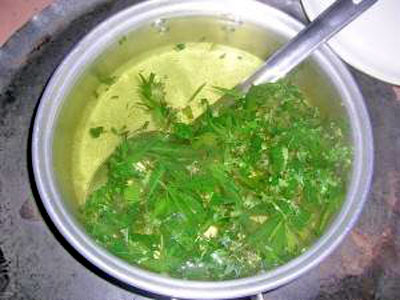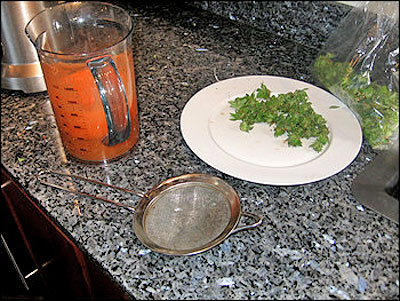|
from IMVA Website
Part 1 December 17, 2011
Fortunately there are options for the administration of cannabis but in general all different ways of administrating hemp oil or raw marijuana can be combined with no harmful side effects.
Also there are vaporizers that allow for
inhalation or what amounts to transdermal treatments into the lungs
without burning the marijuana. It's a cool clean smoke of powerful
medicine.
Smoking "grass" does make a person
relax, which in itself can be quite beneficial. Smoking does help
reduce the symptoms of many conditions but in general it does not
work on a curative level like oral consumption does.
Cannabis, or marijuana, has been utilized as an ingredient in food and drink for thousands of years.
Recipes were often recorded in rhyme, assisting in the memorization process. One such recipe, Bhang (a milk-based drink), dates back to 800 B.C. when it was first concocted in India. The Chinese use of cannabis as a staple food source - for both humans and animals - dates back to the 7th century B.C.
Gathered for their exceptional
nutritional value, cannabis seeds provided an exceptional source of
protein and nutrients.
11-hydroxy THC is thought to be four to
five times more potent than regular THC. This is one reason why
edibles are known to be more potent when compared to inhaled
cannabis. Edibles are also thought to be strong sedatives and many
patients use them for treatment of insomnia.
The general rule is, if you buy an edible product from a registered marijuana dispensary, cut the edible product into four pieces and eat one piece to start. Wait at least one hour. If you feel braver start with half! If you feel the effects of the medication, do not eat any more. If you do not feel the effects of the medication, you can eat another piece.
There have been patients who unknowingly have ingested too much and have felt "too high," nausea, vomiting, and very groggy, so it's best to start out slow in the beginning.
If you do not feel much at a full dose
than try a dose and a half or even two doses.
Marijuana can be used transdermally to
relieve pain from many conditions. Medical marijuana can be a balm,
lotion, ointment or rubbing alcohol solution. In the old days when
people only had plants to use for medication, many patients would
soak marijuana leaves in alcohol and apply them as a poultice to an
arthritic or swollen joint.
Topical marijuana preparations usually provide only local relief and do not have effect on the brain, meaning there is usually no high. This is helpful for those times when marijuana use is inappropriate (like when you have to drive your car) and you still need pain relief!
Topical preparations can be purchased or
made at home.
In many cases, transdermal methods are
used to help avoid potential side effects such as stomach upset or
drowsiness. The full potential for transdermal medicine has not been
explored by modern medicine though it has been practiced for
thousands of years in hot springs around the world.
If the governments would get off their
people's backs, marijuana would be legal and virtually free because
it's so easily grown.
It is highly regrettable that the
deficiency of such an inexpensive, Bottom line, when it comes to pain medications that work on the source of pain and disease, there is nothing like magnesium chloride and nothing like cannabinoid medicine.
Together they are the Batman and Robin
superhero medical team for the world of pain, heavy emotional upset,
and the general treatment of disease. Add sodium bicarbonate (baking
soda) and iodine and you already have a full medical team at your
fingertips.
Then someone had the idea to ask Prof.
Kabelik, who was known for his
research on the medicinal use
of cannabis, for help. He applied his hemp salve and two days later
the wound was already healing and the amputation was avoided.
A Seattle company is reportedly developing a medical marijuana patch for pets, calling it a "question of quality of life."
Jim Alekson's Medical Marijuana Delivery Systems, LLC has patented the patch, called Tetracan, and says it could be used on dogs, cats, and even horses. The patch would be available for human use as well.
According to Alekson, "Dogs suffer from
the same maladies that humans do," and pets can suffer greatly from
pain - everything from arthritis to cancer. He said that harsh
pharmaceutical painkillers have proven harmful, sometimes fatal to
animals.
Dr. William Courtney tells his patients,
It won't get you high eaten raw, and
juiced with a handful of carrots to cut the bitter taste, its leaves
and buds may well offer an important contribution to getting people
well.
Courtney juices carrots to cut the harsh
taste of the ingredients
Kristen Peskuski summarized her return to near-full health - including debilitating lupus, interstitial cystitis, rheumatoid arthritis and 40 medications a day - after juicing fresh pot leaves over a 30-month period.
Courtney's approach promotes marijuana
as a good-for-you vegetable like spinach.
However, the other compounds, such as the terpenes, may have an effect on mood or energy levels.
Raw leaf contains mainly THC acid (not THC) unless you are using a strain that is much higher in CBD. In that case, you will be getting some CBD from the leaf. Leaves are picked from a plant that is about three months of age.
Buds should be at the state where the
trichomes are fully present but not yet amber (i.e. cloudy).
What are the "active" ingredients in raw cannabis if there is no delta-9 THC?
There are more than 525 molecules found in raw cannabis, some with synergistic effects.
According to Dr. Courtney it takes about 4-8 weeks before full clinical benefit is reached. It takes that long to fully saturate the fat tissue with phyto-cannabinoids.
Phyto-cannabinoids are fat molecules that are stored in the adipose or fat tissue similar to the fat-soluble vitamins A, D, E and K.
It appears that a wheat grass juicer is probably the best method of breaking up the cannabis plant cells. Mix with a minimal amount of organic fruit or vegetable juice - just enough to cut the bitter taste of the raw cannabis. Choose lower sugar juices to minimize your ingestion of simple sugars.
Store leaves in a green bag in the
refrigerator; do not rinse until immediately before using. Dr.
Courtney recommends soaking leaves in water for five minutes before
juicing.
|


